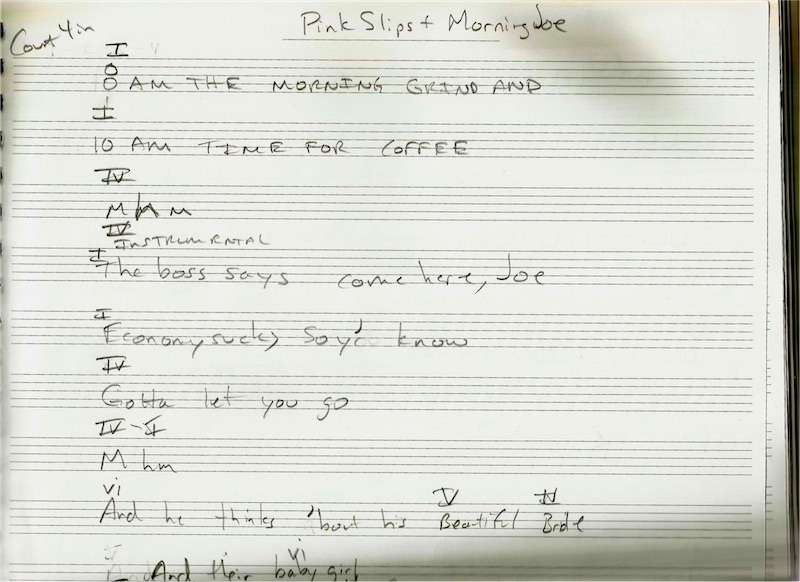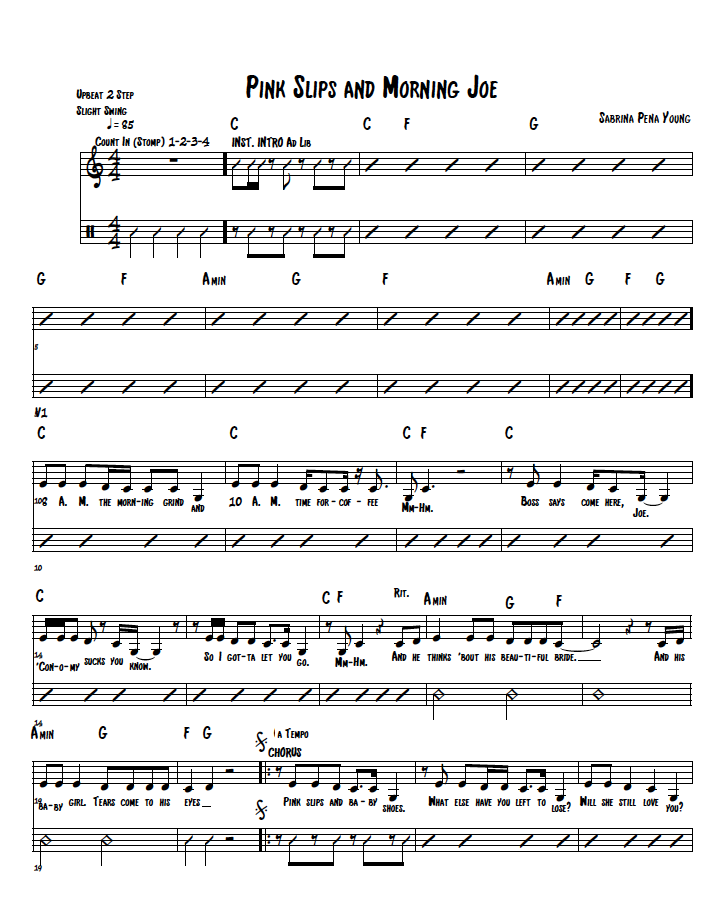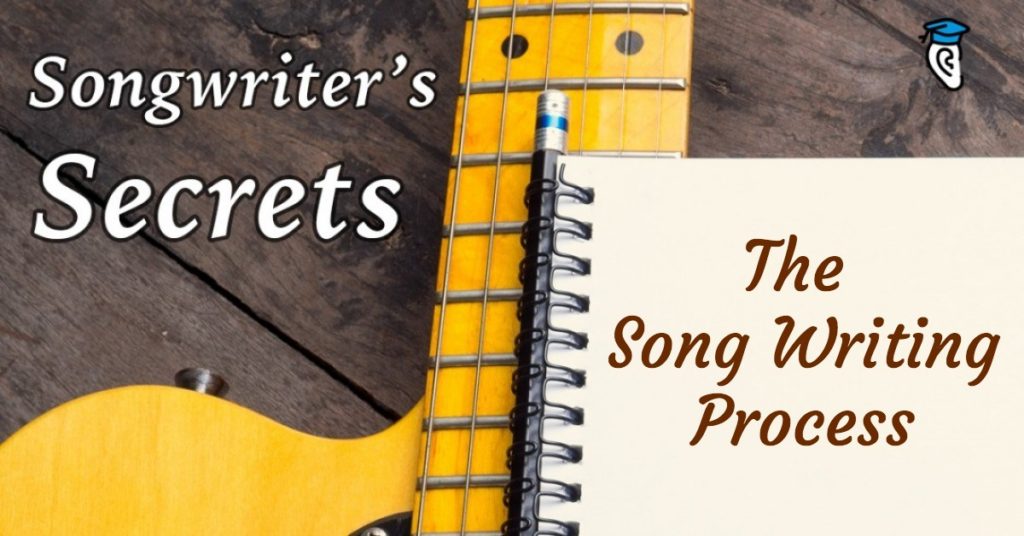In the last article, Songwriter’s Secrets: First Steps, you learned basic exercises to help you start your songwriting journey like practicing your rhyming skills and listening to the top songwriters of all time. Now we will walk you through the songwriting process. While this will look a little different for every musician, you can adapt these steps to suit your own musical skills.
Later on in this series we will unpack each step in-depth to help you further develop the individual skills. This brief overview will help you understand each important step to writing a song from inspiration to recording. We will be using the song Pink Slips and Baby Shoes from the Musical U Classic Chords module to demonstrate the process of writing a simple song.
As mentioned before, not everyone writes the same way. Some musicians find it easier to develop lyrics and a melody after they come up with a rhythm and chord structure that they like. Check out the pro tip below from Germany-based musician Miss Natasha Enquist:
“I enjoy the process of songwriting, and finding the lyrics that fit. Once I have established some kind of chord progression and rhythm, which is based on the mood I want the song to be, I like to play it on repeat and I begin to come up with lyrics through singing anything to be able to find a melody and rhythm so that I can find the shape of the words that fit the music. When it comes to lyrics, I keep my ears open to the world around me and to interesting phrases or points of view, and write them down in a book or on my phone to reference later. I have found using Brian Eno’s Oblique strategies very helpful as well as books of poetry, to spark the creative process.”
– Miss Natasha Enquist
Summer Bird by Miss Natasha Enquist:
Now, let’s look at a step-by-step song writing process you can try:
1. Magical Words
Before you can write a song, you need to know what you want to say. The lyrics of a song usually form the backbone of a tune. While in some genres, like electronica and dance music that depend more on the instrumentals than the lyrics, you will not devote as much time to writing lines, other genres like hip-hop, country, and pop music depend heavily on what the singer actually wants to say. In the next article in this series, How to Write a Song Without an Instrument, you will practice writing good lyrics.
2. Melody and Song Structure
After writing down lyrics it is time for the melody. Where do your melodies come from? There are many ways to develop a melody:
- Do you hum your melodies in your head?
- Do you like to pick up your guitar and work through the melody?
- Do you start with chords and then work out a melody from there?
- Do you and your band members work out the verse and chorus together during a jam session?
In this clip, the songwriter sings a rough version of Pink Slips and Baby Shoes. I recorded this in Logic, which allowed me to use it as a base for developing the harmonic structure, rhythm, and song structure later.
You will also need to work on your song structure. There are several elements like verse, chorus, and bridge that are a part of almost every popular song. Not sure which part of your song is the chorus and which is the verse? Here’s a simple hint: the lyrics that you repeat and are usually the easiest to remember are typically the chorus. The wordier sections are usually the verse. Add in a transition, or “bridge”, near the end for a little pizazz!
3. Harmony and Rhythm
At this point having experience in music theory or playing an instrument like piano or the guitar will be very helpful. As you write out the lyrics, add in chord symbols and set up your song structure. Add in notes about the rhythm. Sometimes a quick note like “steady rock beat” or “swing” is enough of an indication for this first draft of your song’s outline (or “lead sheet”).

In this example above I used a simple notebook to jot down basic chords and lyrics for Pink Slips and Baby Shoes. Using this handwritten lead sheet and a quick recording of her voice, I could put together a score and practice track for the performer prior to the recording session. Notice I had not chosen a key yet – just a basic chord structure based on the I, IV, V, and vi chords.
Remember that at this stage in the process, perfection is not necessary. Listen to this rough take from Pink Slips and Baby Shoes:
Here I was trying to figure out the chord structure and rhythm for the song on piano in Logic. You can hear a basic bass line underneath which I used to develop the harmonic lines. The piano line is not yet perfect and was trashed before the final version below.
Write up a “lead sheet” with chords and lyrics for your performers. If you have excellent music theory chops or need to write for a fuller ensemble, like a swing band or chorus, then you can write out the entire score. Normally though at this beginning stage, a lead sheet with the lyrics and chord symbols on top should be enough to start rehearsing.
4. Record
Rehearse your song until you know it like the back of your hand. Thanks to smartphones, laptops, and innovative apps and software, you no longer need a full studio to record your music. However, if you do have access to a full studio and audio engineers, then take the time to perfect your song prior to the recording session to save on time – and money!

After writing out sheet music for singer Wes Walters, I worked with engineer Matt Poulsen to record Pink Slips and Baby Shoes. Because I had worked methodically developing the song from conception to song structure to lead sheet, the rehearsal went smoothly. Walters read from a lead sheet after practicing for a few days using my basic vocal rough mix. After the recording, I produced the final mix using Logic in my own project studio.
By following the development of the song Pink Slips and Baby Shoes, you went through an example songwriter’s process for writing a simple song. What are some of the song-writing challenges that you face currently? What do you wish you knew more about? Share your thoughts in the comments!








